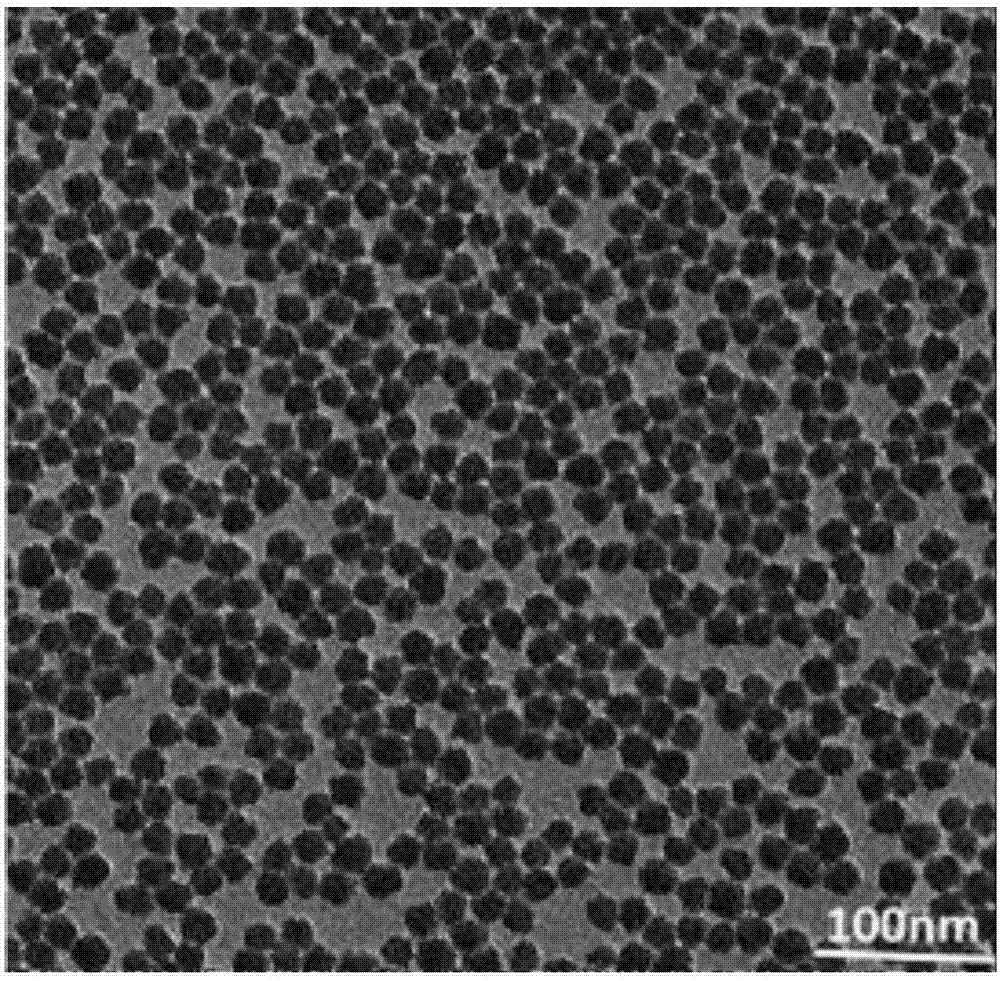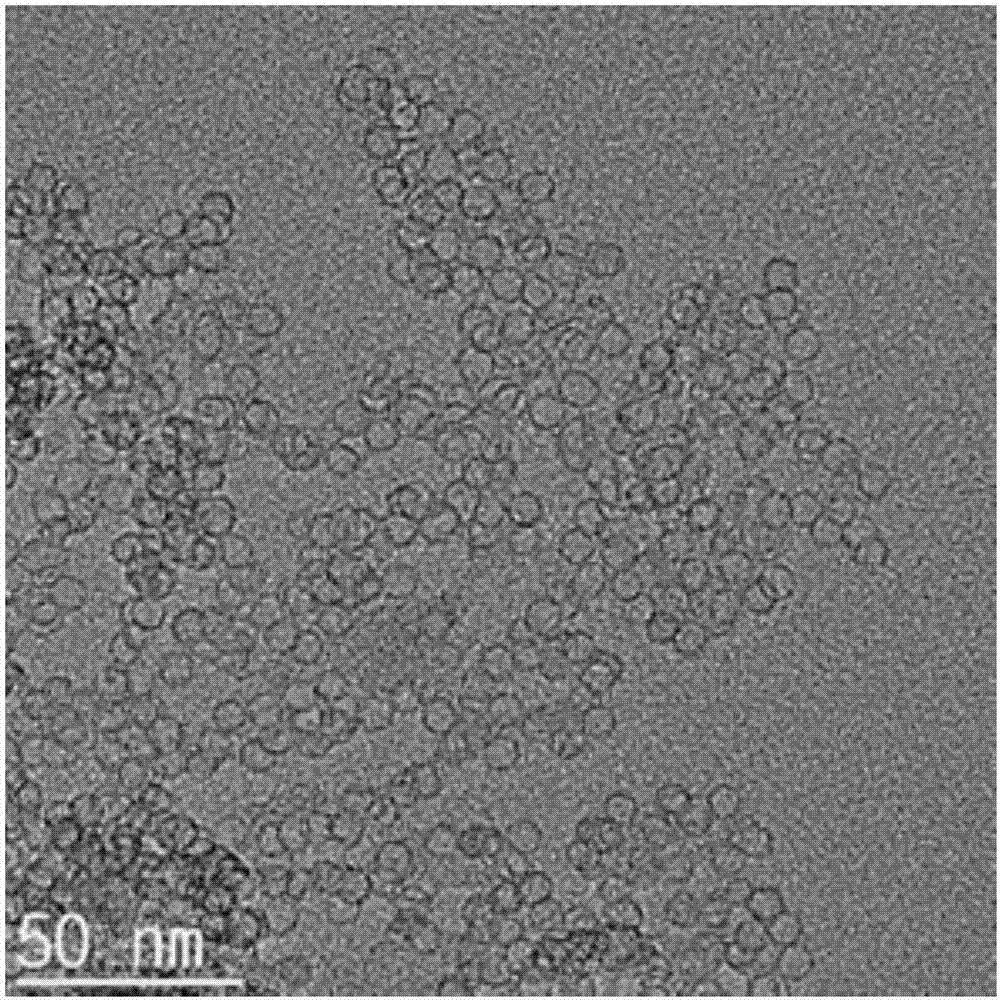Preparation method of hollow vesicular manganous silicate nanoparticles with stable arginine, product and application thereof
An arginine, nanoparticle technology, applied in nanotechnology for sensing, preparations for in vivo experiments, nanotechnology for materials and surface science, etc., can solve the complex synthesis process of contrast agents and cannot be batched. Production and other issues, to achieve the effect of enhancing T1 imaging effect, good biological safety, and good possibility of clinical transformation
- Summary
- Abstract
- Description
- Claims
- Application Information
AI Technical Summary
Problems solved by technology
Method used
Image
Examples
Embodiment 1
[0049](1) Weigh 50mg of arginine, add it to a round bottom flask filled with 40ml of deionized water, stir and dissolve it under the condition of a magnetic stirrer at 500-600r / min, then add 3ml of cyclohexane, and heat to 50°C, Then add tetraethyl orthosilicate (TEOS) 3ml, react for 24 hours, after the reaction is finished, use a separatory funnel to stand and separate, remove the upper layer of cyclohexane, and obtain arginine-stabilized silica nanoparticles.
[0050] The as-prepared arginine-stabilized silica nanoparticles were characterized by TEM, and the results were as follows: figure 1 As shown, the particle size of silica nanoparticles is about 20 nm.
[0051] (2) Weigh 25 mg of potassium permanganate solid, 4 ml of deionized water, 1.5 ml of ethanol, and 0.5 ml of silica nanoparticles (20 mg / ml), mix them and put them into an autoclave, and react at 190 ° C for 24 hours, and cooled to room temperature after the reaction. Then it was washed with deionized water and ...
Embodiment 2
[0056] (1) Weigh 50 mg of arginine, add it to a round bottom flask containing 40 ml of deionized water, stir and dissolve it under the condition of a magnetic stirrer at 500-600 r / min, then add 4 ml of cyclohexane, and heat to 60 °C, Then add tetraethyl orthosilicate (TEOS) 3ml, react for 24 hours, after the reaction is finished, use a separatory funnel to stand and separate, remove the upper layer of cyclohexane, and obtain arginine-stabilized silica nanoparticles.
[0057] (2) Weigh 25 mg of potassium permanganate solid, 4 ml of deionized water, 1.5 ml of ethanol, and 0.5 ml of silica nanoparticles (20 mg / ml), mix them and put them into an autoclave, and react at 200 ° C for 24 hours, and cooled to room temperature after the reaction. Then it was washed with deionized water and centrifuged three times, and finally the obtained arginine-stabilized hollow vesicular manganese silicate nanoparticles were dispersed in 10 ml of water.
Embodiment 3
[0059] (1) Weigh 50 mg of arginine, add it to a round bottom flask containing 40 ml of deionized water, stir and dissolve it under the condition of a magnetic stirrer at 500-600 r / min, then add 3 ml of cyclohexane, and heat to 60 °C, Then add tetraethyl orthosilicate (TEOS) 3ml, react for 30 hours, after the reaction is finished, use a separatory funnel to stand and separate, remove the upper layer of cyclohexane, and obtain arginine-stabilized silica nanoparticles.
[0060] (2) Weigh 25mg of potassium permanganate solid, 4ml of deionized water, 1.5ml of ethanol, 0.5ml of silica nanoparticles (20mg / ml), mix them and put them into an autoclave, and react at 180°C for 30 hours, and cooled to room temperature after the reaction. Then it was washed with deionized water and centrifuged three times, and finally the obtained arginine-stabilized hollow vesicular manganese silicate nanoparticles were dispersed in 10 ml of water.
PUM
| Property | Measurement | Unit |
|---|---|---|
| particle diameter | aaaaa | aaaaa |
| particle diameter | aaaaa | aaaaa |
| particle diameter | aaaaa | aaaaa |
Abstract
Description
Claims
Application Information
 Login to View More
Login to View More - R&D
- Intellectual Property
- Life Sciences
- Materials
- Tech Scout
- Unparalleled Data Quality
- Higher Quality Content
- 60% Fewer Hallucinations
Browse by: Latest US Patents, China's latest patents, Technical Efficacy Thesaurus, Application Domain, Technology Topic, Popular Technical Reports.
© 2025 PatSnap. All rights reserved.Legal|Privacy policy|Modern Slavery Act Transparency Statement|Sitemap|About US| Contact US: help@patsnap.com



